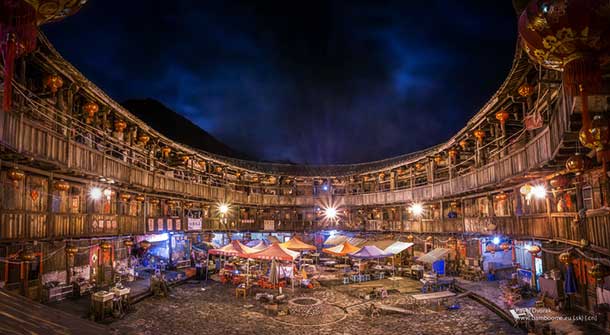Fujian Tulou
Fujian Tulou are recognized as rural dwellings in China. They are located in the south-eastern Fujian, China region and were developed in the 12th and 20th centuries.
Tulou is generally a large, fortified, and enclosed earth building that is mostly designed in circular or rectangular form. These structures have thick load-bearing rammed earth walls with an estimated height of three to five stories and may permit the living space for almost 800 people. Several small interior buildings are usually enclosed within large peripheral walls that can have wells, halls, storehouses, and living areas. In simple words, the entire structure turns out to be more like a fortified city.
These buildings were designed decades ago with a goal to create a solid defense system for the residents inside. They have only one entrance terminal, and the windows are added only above the first floor. These clans used to function more like a village unit and were widely known as little family kingdoms or bustling, tiny cities. Fujian Tulou features tall mud walls that are capped using tiled roofs and overhanging eaves.
The most famous Fujian Tulou structures were developed in the 17th and 18th centuries. These well-planned buildings were divided between different families in vertical arrangements. It means one family used to have two or three rooms on every floor. Even with the plain exterior from the outside, these buildings used to provide complete comfort to the residents inside and could have highly decorated interiors.
The fortified outer structures of these buildings are designed by using a mixture of stone wood, bamboo, and other easily available materials. These walls have an extensive thickness of up to 6 feet. Strips. Branches, bamboo chips, and wood are commonly added to the wall structures for enhanced reinforcement. As a result, the residents can have windproof, well-ventilated, and earthquake-proof buildings that stay cool in the summer and warm in the winter season.
Most of the Tulou buildings are found in the small geographical areas near the boundaries of Pinghe, Nanjing, and Yongding of Fujian province. Many such structures are also found in the neighboring Guangdong province. They are listed among some of the most famous tourist sites in the country. Almost 46 Fujian Tulou sites in China are listed as World Heritage Sites by UNESCO in the year 2008. They are recognized as exceptional examples of defensive organizations that support communal living by establishing harmonious relationships in the surroundings.
|

|
|
Since the 1980s, Fujian Tulou structures are better known as an earth dwelling, a Hakka Tulou, and a strong roundhouse. Many journal publications have also talked about these structures while highlighting the advantages of such neighborhoods. The concept of Tulou structures is connected to a long-standing tradition of designing defensive buildings promoting communal living. The ideas of collaboration, harmony and cultural effectiveness are widely documented in relevance to these living spaces. Moreover, these structures are exceptional in terms of function, building traditions, size, social and economic histories.
|

